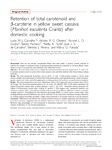Please use this identifier to cite or link to this item:
http://www.alice.cnptia.embrapa.br/alice/handle/doc/931469| Title: | Retention of total carotenoid and B-carotene in yellow sweet cassava (Manihot esculenta Crantz) after domestic cooking. |
| Authors: | CARVALHO, L. M. J.  OLIVEIRA, A. R. G.   GODOY, R. L. O.   PACHECO, S.   NUTTI, M. R.   CARVALHO, J. L. V. de   PEREIRA, E. J.   FUKUDA, W. G.   |
| Affiliation: | LUCIA MARIA JAEGER DE CARVALHO, UFRJ; ALCIDES R. G. OLIVEIRA, UFRJ; RONOEL LUIZ DE OLIVEIRA GODOY, CTAA; SIDNEY PACHECO, CTAA; MARILIA REGINI NUTTI, CTAA; JOSE LUIZ VIANA DE CARVALHO, CTAA; ELENILDA J. PEREIRA, UFRJ; WÂNIA G. FUKUDA, CNPMF. |
| Date Issued: | 2012 |
| Citation: | Food & Nutrition Research, v. 56, 2012. 15788. |
| Description: | Background: Over the last decade, considerable efforts have been made to identify cassava cultivars to improve the vitamin A nutritional status of undernourished populations, especially in northeast Brazil, where cassava is one of the principal and essentially only nutritional source. Objectives: The aim of this study was to evaluate the total carotenoid, ?-carotene, and its all-E-, 9-, and 13-Z-?- carotene isomers content in seven yellow sweet cassava roots and their retention after three boiling cooking methods. Design: The total carotenoid, ?-carotene, and its all-E-, 9-, and 13-Z-?-carotene isomers in yellow sweet cassava samples were determined by ultraviolet/visible spectrometry and high-performance liquid chromatography, respectively, before and after applying the cooking methods. All analyses were performed in triplicate. Results: The total carotenoid in raw roots varied from 2.64 to 14.15 µg/g and total b-carotene from 1.99 to 10.32 µg/g. The b-carotene predominated in all the roots. The H?brido 2003 14 08 cultivar presented the highest b-carotene content after cooking methods 1 and 3. The 1153 Klainasik cultivar presented the highest 9-Z-?-carotene content after cooking by method 3. The highest total carotenoid retention was observed in cultivar 1456 Vermelhinha and that of b-carotene for the H?brido 2003 14 11 cultivar, both after cooking method 1. Evaluating the real retention percentage (RR%) in sweet yellow cassava after home cooking methods showed differences that can be attributed to the total initial carotenoid contents. However, no cooking method uniformly provided a higher total carotenoid or ?-carotene retention in all the cultivars. Conclusion: Differences were found in the cooking methods among the samples regarding total carotenoid or ?-carotene retention, suggesting that the different behaviors of the cultivars need to be further analyzed. However, high percentages of total carotenoid or ?-carotene retention were observed and can minimize vitamin A deficiency in low-income populations. |
| Keywords: | Mandioca amarela Retenção de carotenóide B-caroteno Métodos caseiros de cozimento |
| DOI: | 10.3402/fnr.v56i0.15788 |
| Type of Material: | Artigo de periódico |
| Access: | openAccess |
| Appears in Collections: | Artigo em periódico indexado (CTAA)  |
Files in This Item:
| File | Description | Size | Format | |
|---|---|---|---|---|
| 2012035.pdf | 323.29 kB | Adobe PDF |  View/Open |









